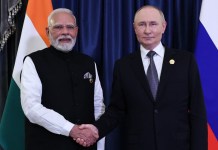The biography of Maman Wani is intriguing. His articles and letters, which talk about love for peace, but not at the cost of freedom have found many appreciators. Manan Wani, the scholar turned militant, was killed by the Indian security forces, but his death came as a total surprise to his family members as the police had categorically denied the news initially. EurAsian Times analyses how Manan Wani was killed and why he was more dangerous than the other Wani – Burhan.
- Manan Wani – PhD Scholar Turned Militant Dead; Did Not Surrender
- Pakistan Promotes The Struggle of Kashmiri Pandits, But Accidentally
- Iranian Shia Clerics Under Scrutiny in Kashmir For Fiery Speeches
A joint team of Indian army’s 30 Rashtriya Rifles and Special Operations Group (SOG) had laid a siege around few houses in Shatgund village. The forces cornered the area at around 2 am after a specific intelligence input.
Inside one of the houses was Mannan Wani, a writer, scholar, and a rebel. The militant commander was spreading his “agenda” by his writings. His two articles, where he had justified his decision of choosing the gun, had become immensely popular.
Mannan’s writings were making him popular. “It was not the gun that was disturbing us, but Mannan’s write-ups were becoming instrumental in propagating the message of militants. It was luring more youth towards militancy,” the top police official told to News18, Indian Channel.
The growing admiration for Mannan Wani was worrying the Indian defence forces, according to reports by Indian Media. They feared his death would create a law and order situation (just like Burhan Wani). Burhan’s killing was followed by months of unrest in which over a hundred people lost their lives, while a thousand others were injured.
Operation Mannan
Mannan Wani was operating from South Kashmir, the hotbed of militancy in the valley. However, since the last 15 days, there was an intelligence report that Wani would be travelling to north Kashmir to cross over to Pakistan.
Mannan Wani managed to reach North Kashmir from South, an official from the team tracking Mannan revealed. “We had inputs that Mannan is putting up in a Baramulla village. He came to Shatgund village on Thursday. We were following his movement,” the officer said to Indian Media Channel.
At around 2 in the night, the cordon was laid and in the early morning, Mannan Wani and his associate were killed. The local intelligence was absolutely correct, the police said. Post his encounter, the senior officials of the Indian army ordered that no picture should come out of the slain terrorist, as this could create law and order situations, like in the case of Burhan Wani.
In 2016, when Burhan was killed his picture lying on a stretcher with blood stains on his t-shirt and his face had gone viral on social media minutes after the encounter. Police officials believe that it was the trigger point.
How SOG Confused the People
“We carried Mannan’s corpse in a body bag from the encounter site to keep his face concealed. Otherwise, after an encounter, the locals identify the militant and spread the news, making the task tough for us,” the police official said.
By the time body of Mannan and his associate was taken to the police station, the government had ordered the closure of schools and colleges in north Kashmir. “We made sure that there are no gatherings, protests or stone-throwing incidents,” the police official said.
Confusion was created among the people. Rumours about Mannan Wani’s killing were in the air but police officials affirmed that “the news was a hoax”. “Before breaking the news of Mannan’s death, restrictions were put in place,” the top police official said. “We didn’t want the situation to look unusual. The internet was not shutdown in the entire valley, which is usually done after such encounters.”
Wani’s body wasn’t handed over to family in the police station, which is the regular procedure. The body was brought in an armoured vehicle and was handed over to the relatives in nearby Chandigam village.




